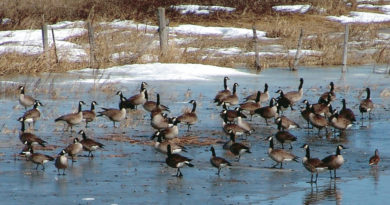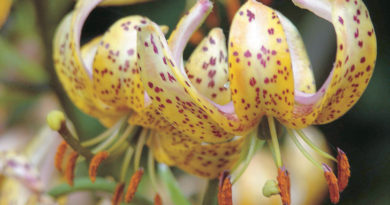The Acrobatic Nuthatches
By Ken De Smet
Photo by Jim Reimer
Along with black-capped chickadees and the common woodpeckers (downy and hairy), white-breasted and red-breasted nuthatches are probably among the most widespread of feeder birds in southern Manitoba. Depending on surrounding habitat and the type of year it is, however, you may not get both nuthatches at your feeder on a regular basis. Where there are mature deciduous woods, in agricultural regions and many parts of the south, the white-breasted nuthatch is the species you are most likely to encounter. Red-breasted nuthatches are more likely to occur in mixed coniferous/deciduous stands, near spruce forests and in coniferous-dominated areas. But they can be found at feeders throughout southern Manitoba during migration and in some years frequent these feeders throughout the winter.
Nuthatches are most often recognized for their gravity-defying struts head-first down tree trunks, often spiralling down the entire trunk in search of food. They are the only birds in our area that have this unusual habit. By traveling head-first, it is believed they can search in nooks and crannies in the bark for tiny organisms overlooked by other birds which move in an upright fashion as they search. Unlike woodpeckers or brown creepers, which usually travel upward and use their tails to brace themselves against the trunk, nuthatches grasp and hold on using foot power alone. Nuthatches have a very short tail (perhaps so it won’t get in the way) and a strong hind toe that provides secure footing. The term nuthatch arises from their habit of wedging seeds or nuts in the crevice of a tree trunk and hammering or “hatching” the food open with their bills.
As their names suggest, white-breasted and red-breasted nuthatches are best recognized by the colouration of their undersides. White-breasted are white with rusty under tail streaks. Male red-breasted nuthatches have rich rusty undersides, whereas females and immatures have a faint rusty wash. White-breasted nuthatches are noticeably larger, and have a greyish-blue back and dark grey cap (females) to black cap (in males). Red-breasted nuthatches are also grey above with a darker cap. However, in contrast to the solid white face of the white-breasted, red-breasted nuthatches have a very distinct black eye-line bordered with white.
The “yank-yank-yank” calls of the red-breasted are higher pitched and more nasal than that of white-breasted nuthatch; in fact, the red-breasted calls have been compared to the sound of the original toy tin horn.
Nuthatches are regular visitors to winter feeders and they are said to be especially fond of beef suet, a delicacy that can be purchased at most butcher shops. They are also fond of cracked nuts and sunflower seeds, which are often carried off whole from the feeder and wedged into the bark of a nearby tree for later use. Nuthatches are adept at finding invertebrates, insect eggs and larva under loose bark or in crevices. They have even been observed using a sliver of wood as a tool to aid them in searching for and extracting insects under loose bark.
Although both nuthatches readily take seeds, wild or planted spruce trees that are laden with cones are a particularly important natural seed source for red-breasted in the fall and winter. In fact, in years when there is a poor crop of cones on the spruce trees, few red-breasted nuthatches will be found at feeders and almost none linger in southern Manitoba through the winter.
Nuthatches nest in natural cavities or old woodpecker holes in rotting trees or branches. They may even select a well-placed nest box for nesting or roosting purposes. The cavity is lined with bits of bark, grasses, moss, fur and/or feathers. Red-breasted nuthatches have a habit of smearing sap or resin from conifers around the nest entrance, probably to discourage predators. Standing dead trees or “snags” are often used for nesting and are often an important source of food for nuthatches, woodpeckers and species that forage on invertebrates. Hence, it is always a good idea to keep some snag trees, or better yet remove as few snags as possible, when thinning or maintaining a woodlot on your property.
Female nuthatches lay five to 10 eggs and incubate them for 12 to 14 days. Young are cared for by both parents until well after they leave the nest (at about two weeks of age). Although the young of both species disperse to some degree, white-breasted nuthatch pairs tend to remain together on or near their nesting territory year-round. Red-breasted nuthatches are more nomadic, as most or all migrate southward or roam extensively in search of food.
Ken De Smet is an endangered species biologist with Manitoba’s wildlife branch.




